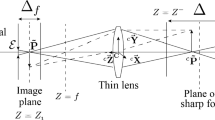Abstract
This paper presents an overview of a hybrid test strategy for ADAS functions testing and validation. The hybrid test strategy represents a combination of real and virtual validation procedure providing a substitute to elaborate real tests in the development process. ADAS sensor – front view camera – modeling approaches are presented where the causes of relevant optical aberrations and their effects on the acquired images are investigated. In this context, distortion, blur and vignetting models are created and demonstrated. Additionally, a toolchain, a method for camera simulation and testbed setups are defined and presented as enablers for hybrid test strategies.
Zusammenfassung
Dieser Beitrag gibt einen Überblick über eine hybride Teststrategie für das Testen und Validieren von ADAS-Funktionen. Die hybride Teststrategie stellt eine Kombination aus realem und virtuellem Validierungsverfahren dar, die einen Ersatz für die Ausarbeitung realer Tests im Entwicklungsprozess darstellt. ADAS-Sensor – Frontsichtkamera – Modellierungsansätze werden vorgestellt, bei denen die Ursachen relevanter optischer Aberrationen und deren Auswirkungen auf die aufgenommenen Bilder untersucht werden. In diesem Zusammenhang werden Verzerrungs-, Unschärfe- und Vignettierungsmodelle erstellt und demonstriert. Zusätzlich werden eine Werkzeugkette und Methode für Kamerasimulation sowie Prüfstandsaufbauten definiert und als Enabler für hybride Teststrategien vorgestellt.


















Similar content being viewed by others
References
Blochwitz, T., Otter, M., Arnold, M., Bausch, C., Clauß, C., Elmqvist, H., Junghanns, A., Mauss, J., Monteiro, M., Neidhold, T., Neumerkel, D., Olsson, H., Peetz, J.-V., Wolf, S. (2011): The functional mockup interface for tool independent exchange of simulation models.
Brown, D. (1966): Decentering distortion of lenses. Photogramm. Eng., 7, 444–462.
Carr, K. (1997): Surf. Coat. Int., 80, 485. https://doi.org/10.1007/BF02692721.
Conrady, A. (1919): Decentered lens systems. Mon. Not. R. Astron. Soc., 79, 384–390.
Francis, A. J., Harvey, E. W. (2001): Fundamentals of optics. 4th ed. United States of America: McGraw-Hill Companies.
Google, Protocol Buffers (2017): https://developers.google.com/protocol-buffers/. Online; accessed 12, March-2018.
Hanke, T., Hirsenkorn, N., van-Driesten, C., Garcia-Ramos, P., Schiementz, M., Schneider, S., Biebl, E. (2017): Open simulation interface. https://www.hot.ei.tum.de/forschung/automotive-veroeffentlichungen/. Online; accessed 12. March-2018.
Lin, P. D. (2017): Advanced geometrical optics. Singapore: Springer.
Sinha, P. K. (2012): Image acquisition and preprocessing for machine vision systems. Washington: SPIE Press.
Winner, H., Hakuli, S., Lotz, F., Singer, C. (2016): Handbook of driver assistance systems. Switzerland: Springer.
Author information
Authors and Affiliations
Corresponding author
Rights and permissions
About this article
Cite this article
Schneider, SA., Saad, K. Camera behavioral model and testbed setups for image-based ADAS functions. Elektrotech. Inftech. 135, 328–334 (2018). https://doi.org/10.1007/s00502-018-0622-7
Received:
Accepted:
Published:
Issue Date:
DOI: https://doi.org/10.1007/s00502-018-0622-7




